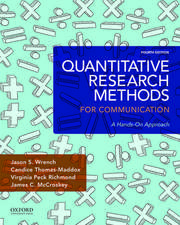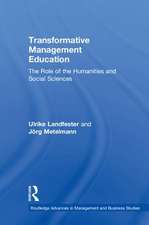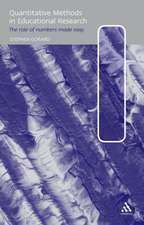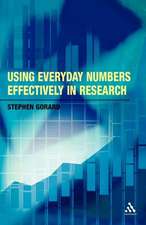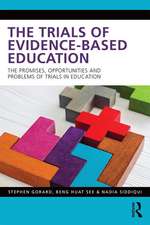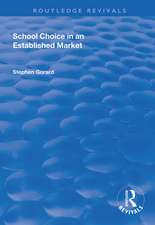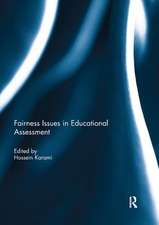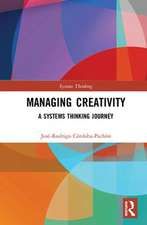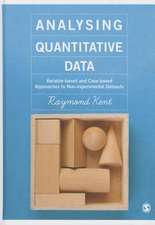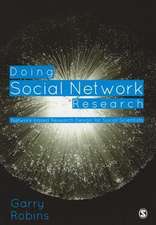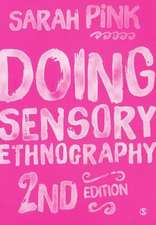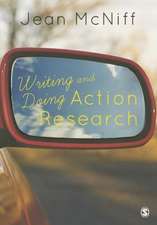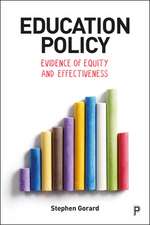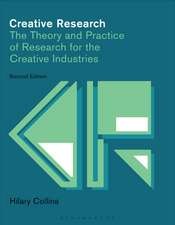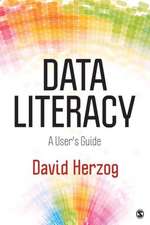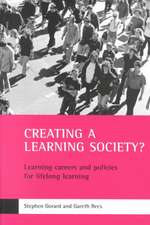How to Make Sense of Statistics
Autor Stephen Gorarden Limba Engleză Paperback – 23 feb 2021
Understanding why we have to learn statistics and seeing the links between the numbers and real life is a crucial starting point. Using engaging, friendly, approachable language this book will demystify numbers from the outset, explaining exactly how they can be used as tools to understand the relationships between variables.
This text assumes no previous mathematical or statistical knowledge, taking the reader through each basic technique with step-by-step advice, worked examples, and exercises. Using non-inferential techniques, students learn the foundations that underpin all statistical analysis and will learn from the ground up how to produce theoretically and empirically informed statistical results.
| Toate formatele și edițiile | Preț | Express |
|---|---|---|
| Paperback (1) | 317.55 lei 3-5 săpt. | +27.79 lei 4-10 zile |
| SAGE Publications – 23 feb 2021 | 317.55 lei 3-5 săpt. | +27.79 lei 4-10 zile |
| Hardback (1) | 936.09 lei 6-8 săpt. | |
| SAGE Publications – 23 feb 2021 | 936.09 lei 6-8 săpt. |
Preț: 317.55 lei
Nou
Puncte Express: 476
Preț estimativ în valută:
60.78€ • 66.05$ • 51.09£
60.78€ • 66.05$ • 51.09£
Carte disponibilă
Livrare economică 31 martie-14 aprilie
Livrare express 14-20 martie pentru 37.78 lei
Preluare comenzi: 021 569.72.76
Specificații
ISBN-13: 9781526413826
ISBN-10: 1526413825
Pagini: 320
Dimensiuni: 170 x 242 x 24 mm
Greutate: 0.51 kg
Ediția:1
Editura: SAGE Publications
Colecția Sage Publications Ltd
Locul publicării:London, United Kingdom
ISBN-10: 1526413825
Pagini: 320
Dimensiuni: 170 x 242 x 24 mm
Greutate: 0.51 kg
Ediția:1
Editura: SAGE Publications
Colecția Sage Publications Ltd
Locul publicării:London, United Kingdom
Recenzii
This book takes beginner students hand-in-hand through a journey in the world of statistics without dumbing down the concepts, just making them very accessible. It teaches the basics (and beyond) by stimulating critical thinking.
Cuprins
Part I: Introduction
Chapter 1: Why we use numbers in research
Chapter 2: What is a number?: Issues of measurement
Part II: Basic analyses
Chapter 3: Working with one variable
Chapter 4: Working with tables of categorical variables
Chapter 5: Examining differences between real numbers
Chapter 6: Significance tests: how to conduct them and what they do not mean
Chapter 7: Significance tests: why we should not report them
Part III: Advanced issues for analysis
Chapter 8: The role of judgement in analysis
Chapter 9: Research designs
Chapter 10: Sampling and populations
Chapter 11: What is randomness?
Chapter 12: Handling missing data: The importance of what we don’t know
Chapter 13: Handling missing data: more complex issues
Part IV: Modelling with data
Chapter 14: Errors in measurements
Chapter 15: Correlating two real numbers
Chapter 16: Predicting measurements using simple linear regression
Chapter 17: Predicting measurements using multiple linear regression
Chapter 18: Assumptions and limitations in regression
Chapter 19: Predicting outcomes using logistic regression
Chapter 20: Data reduction techniques
Part V: Conclusion
Chapter 21: Presenting data for your audience
Chapter 1: Why we use numbers in research
Chapter 2: What is a number?: Issues of measurement
Part II: Basic analyses
Chapter 3: Working with one variable
Chapter 4: Working with tables of categorical variables
Chapter 5: Examining differences between real numbers
Chapter 6: Significance tests: how to conduct them and what they do not mean
Chapter 7: Significance tests: why we should not report them
Part III: Advanced issues for analysis
Chapter 8: The role of judgement in analysis
Chapter 9: Research designs
Chapter 10: Sampling and populations
Chapter 11: What is randomness?
Chapter 12: Handling missing data: The importance of what we don’t know
Chapter 13: Handling missing data: more complex issues
Part IV: Modelling with data
Chapter 14: Errors in measurements
Chapter 15: Correlating two real numbers
Chapter 16: Predicting measurements using simple linear regression
Chapter 17: Predicting measurements using multiple linear regression
Chapter 18: Assumptions and limitations in regression
Chapter 19: Predicting outcomes using logistic regression
Chapter 20: Data reduction techniques
Part V: Conclusion
Chapter 21: Presenting data for your audience
Notă biografică
Stephen Gorard is Professor of Education and Public Policy, and Director of the Evidence Centre for Education, at Durham University (https://www.dur.ac.uk/). He is a Fellow of the Academy of Social Sciences, member of the ESRC Commissioning Panel for the Research Methods Programme, the British Academy grants panel, and Lead Editor for BERA¿s Review of Education. He is a member of the Cabinet Office Trials Advice Panel as part of the Prime Minister¿s Implementation Unit.
His work concerns the robust evaluation of education as a lifelong process, focused on issues of equity, especially regarding school intakes. He is author of around 30 books and over 1,000 other publications. He is currently funded by Nesta to evaluate their EdTech Testbed, and by the British Academy to look at the impact of schooling in India and Pakistan.
His work concerns the robust evaluation of education as a lifelong process, focused on issues of equity, especially regarding school intakes. He is author of around 30 books and over 1,000 other publications. He is currently funded by Nesta to evaluate their EdTech Testbed, and by the British Academy to look at the impact of schooling in India and Pakistan.
Descriere
In a new textbook designed for students new to statistics and social data, Gorard focuses on non-inferential statistics as a basis to provide readers with fundamental statistical literacy. Assuming no previous statistical knowledge, the author demystifies the subject in an engaging and approachable style.

